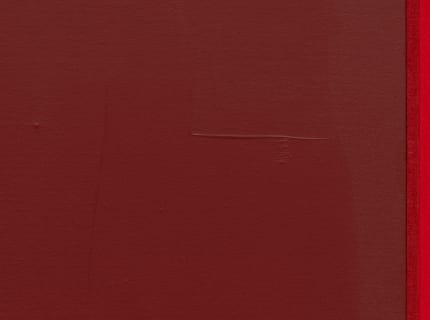Jennie C. Jones makes abstract work using paint, sound, and audio equipment such as acoustic panels and bass traps. Her multimedia exhibition “Directions: Jennie C. Jones: Higher Resonance” joins thirteen new works with a looped composition played through elevated speakers. The curved exterior gallery of the Gordon Bunshaft–designed Hirshhorn Museum—often an odd counterpoint to the austere rectilinearity of much of its collection—is made a virtue here, as Jones has converted its arced space into an acoustic chamber for music that seeps invitingly into the surrounding corridor.
In the introductory wall text, the show’s curator, Evelyn Hankins, promises works that nod to Minimalism; engage “social, political, and historical concerns”; and “highlight what is missing from the legacy of American modernism.” This is an ambitious interpretation of what lies within; and one infers, from the notes resonating throughout the gallery, citing legendary African American composers of the avant-garde, that “what is missing” is modernism’s debt to black culture, music culture, or both. But have we really forgotten such connections? Mondrian’s last paintings were famously inspired by New York’s swinging boogie-woogie; Jackson Pollock and Norman Lewis alike looked to the improvisational freedom of uptown jazz; and de Kooning once declared that he bent paint the way a trumpeter bent a blue note. In other words, the commonplace mythology of two of America’s major twentieth-century exports already accounts for their strong mutual affinities (imagined, purloined, or otherwise), and such complex connections are still being actively investigated in major exhibitions and contemporary discourses.
Less explored, perhaps, are the persistent interrelations of art and jazz as each moved within the Minimal and post-painterly registers of the 1960s and early ’70s. In both cases, the gesture of the author often receded in favor of harder lines, more dissonant sounds, and seriality. One does not have to look far to find a constellation joining Sol LeWitt, Steve Reich, Cecil Taylor, Eric Dolphy, and Al Loving, for example. Such relations are not one-to-one, and they bespeak a set of connections more formal than romantic. What Jones does is present a kind of counterfactual: What if modernist painting merged with the experimental music, Conceptual systems, and specific objects of the ’60s, rather than hewing to its own medium-specific investigations and facing pointed opposition in the decade that followed? What if an alliance of modernist abstraction and dissonant jazz could be articulated, rather than left as a case of sublimation or indirect influence?
Initially, the answer is inconclusive. For all their satisfying formal elegance and careful arrangement, the modular panels of muted gray and accents of black and near-chartreuse conjure that modernist bête noire, the decorative. If divested of their status as artwork, the music and objects might fit neatly within a Scandinavian design shop, while the three screenprinted arrays of lines formed by bass strings (“Static Reverberation/String Arrangements #1–3,” 2012) veer into one-liner territory.
And yet despite its seemingly light touch, the installation remains a tour de force of precision and control. Although Jones’s audio element may at first sound like merely ambient drone, a closer listen reveals it to be an intricate embroidery of “microsamples” from many various tracks, all by African American composers, from Rahsaan Roland Kirk to Alvin Singleton. Above all, these works invite patience; bursts of sound and silence call attention to each object in turn, heightening its subtle balance of planes and shifts in gradient. The paintings, for their part, literally amplify and reverberate the sound. Such constructive interference transcends mere affinity and, once upon a time might have been called a dialectic. In other words, Jones’s installation does not so much account for the various socio-political repressions of modernism as it opens up its more structural and phenomenological conditions—medium specificity, instantaneity, and opticality—to great effect. Situated thirty-five feet from Louise Nevelson’s shadowy 1964 sculpture Silent Music IX and breaking the hushed piety of the modernist museum, “Higher Resonance” plays us abstraction, made new once again.
...
Read full article at artforum.com.

